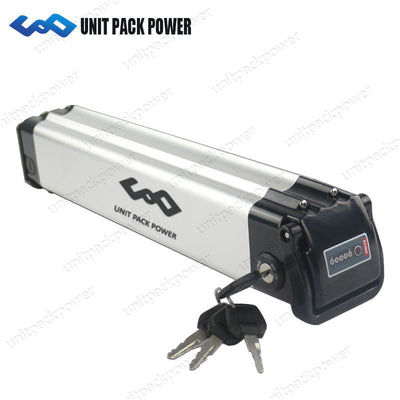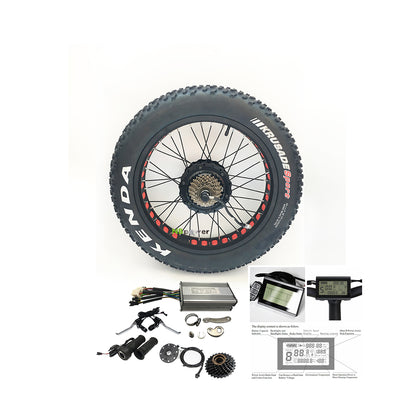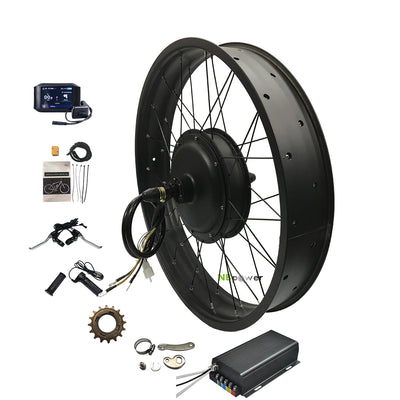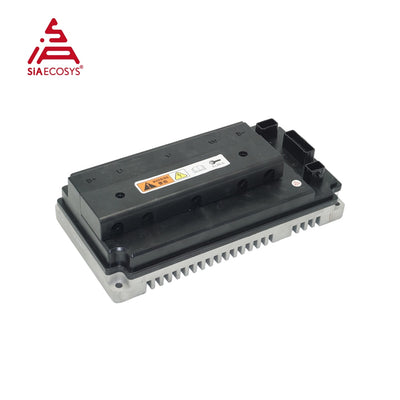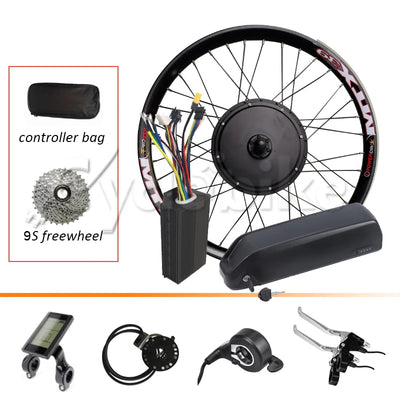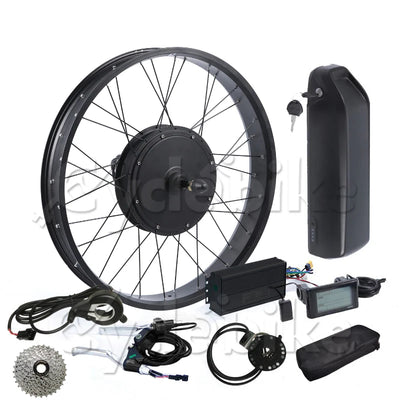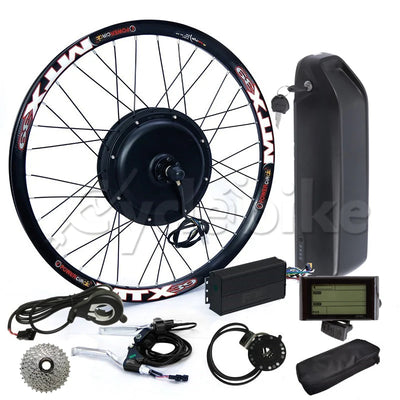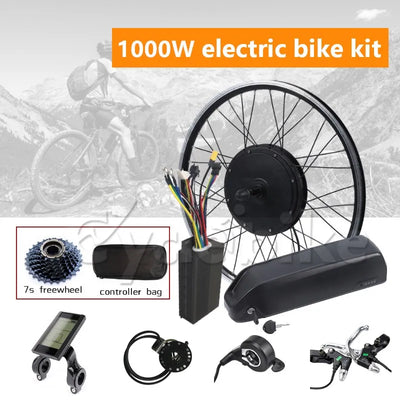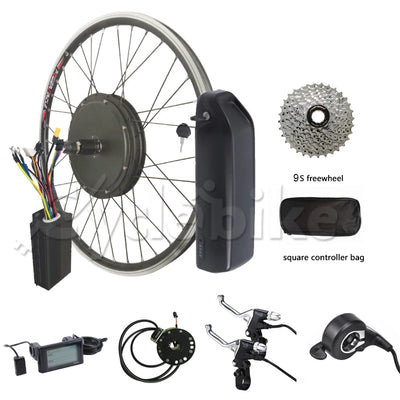Electric Bike Kit Guide: Make Your Current Bike More Fun!
Posted by Tom Lee on
Electric bike kits are a solution that allow you to add a motor, battery and electric controls to a non electric bike to make it into an e-bike.
Chosen with care and installed correctly, the resulting e-bike lets you ride with electric assist just like a ‘regular’ e-bike.
With the evergrowing range of readymade e-bike designs larger than ever, kits have some competition from off-the-peg, ready to pedal e-bikes.
However, they still offer positive advantages as well as some drawbacks which are considered first-off.
Pros
You Like Your Current Bike: You might want a bit of power assistance on a cherished non-electric machine that fits you like a glove.
Unique Bikes: The type of bikes you prefer may not be available in electric versions (folders and recumbents are cases in point, though more are appearing on the market, especially e-folders). E-bike conversions can be useful at the ends of the power envelope less catered for by off the peg e-bikes, that is to say moderately powered but very ‘bikelike’ machines or at the other end of the scale, power hungry beasts.
Swapping: Kits can be swapped between bikes, giving the option of trying electric-assist on several different machines. Similarly, if the kit is a very easy to remove front hub wheel kit (for example as is the case with Leeds, Cytronex, Electron Wheel, etc.), you can use your bike unassisted at any time by simply swapping the wheel back to the original and leaving the battery off (the bike then weighs just a few hundred grams more than before). With such systems you can also choose at any time to electrify more than one bike and fully utilise your battery, just by swapping it between bikes.
Greener: If you already have a bike you want to make electric, kits are generally a ‘greener’ option than a brand new e-bike, for the obvious reason they don’t need another brand new bike to be manufactured to replace the one you have bought!
Tinkering: Those who love fiddling with bikes may be intrigued by the endless permutations of motor kits and bikes – the performance of a kit will be affected by the bike it is fitted to. Hub motors are usually geared for a specific wheel size to ensure they stay within the speed limit set for electric bikes in the territory in which they are sold. However, to take one example of how you can play with the design characteristics of motors and bikes, if you fit a hub motor geared for a larger wheel into a smaller one it will give excellent pulling power at low speeds, producing an excellent hill-climber or load-hauler.

Leeds electric bike kit on an Electra bike.
Great Value: Kits can be great value for money. If you have a ‘recipient’ bike languishing in the shed or have picked up a decent quality steed at a good price, it can be converted quite cheaply when compared to the cost of a new e-bike of similar quality. Do note the Fitter’s Responsibilities section below about the quality of the recipient bike you might want to fit a kit to.
Lightweight: Kits also make it possible to put together an incredibly lightweight electric bike – a total weight of 22 pounds or 10kg is actually possible, and if money really is no object even lighter!
IMPORTANT NOTE: Kits containing illegal motors and control units are in the market, and many people are using them on the road, either innocently or otherwise. A fast and/or powerful kit can be a lot of fun, but bear in mind that once you exceed the parameters set in the regulations, you are on your own. In most territories, your bicycle will be treated as a moped in the eyes of the law, and subject to the much more stringent penalties that come with motorcycle use. If you are found responsible for injuring someone, you will be in very serious trouble. The electric bike legislation is a safety net for your protection, and you leave it at your own risk.
Cons
May Be Complicated: Some kits are easier to fit than others, but most require at least basic bike DIY skills. However, the simplest, such as the Leeds system and the rather more sophisticated Cytronex system really only require you to install a wheel, mount the battery on your bike and attach a basic cable run, so don’t really require any specialist bike knowledge. All-In-One Wheels also offer an easy install option.
Somewhat Limited: If you want a crank-drive system your choice is very limited and they are more difficult to fit than most hub motor systems.
Aesthetics: Often kits will not look as neat as off-the-peg electric bikes. External cable runs secured with cable ties are the order of the day, whilst most complete electric bikes nowadays come with cables hidden within the frame.
May Not Fit: Not all kits will fit all bikes. Attention needs to be paid to getting the correct speed of motor for your size of wheel (although most hub motors come ready spoked into the correct size of wheel) and finding a suitable battery mounting point amongst many other factors. Front hub motor kits are generally easier to fit than rear hub kits simply because they don’t involve interfering with the gear system. Some kits must be fitted by a qualified fitter whilst with others it is only recommended unless you are a very competent bike mechanic.
Quality: As with complete electric bikes, quality varies from kit to kit: Heinzmann for example stand out in this regards because of its high quality connectors and cabling, giving you the confidence to produce smooth tight cable runs, minimising the kit’s visual impact.
Buying and Fitting Tips
Geared or direct drive system?
 The vast majority of systems are geared, whereby the motor power needs to be geared down via a set of compact gears on its way to the hub shell. They are fixed gear, usually being geared to achieve a maximum speed of 15.5mph or 20mph (depending whether you are buying a European or US spec kit). However, they may be geared to give the maximum amount of hill climbing ability and so the top assisted speed of the motor may (rarely) be less than the actual legal power assist limit.
The vast majority of systems are geared, whereby the motor power needs to be geared down via a set of compact gears on its way to the hub shell. They are fixed gear, usually being geared to achieve a maximum speed of 15.5mph or 20mph (depending whether you are buying a European or US spec kit). However, they may be geared to give the maximum amount of hill climbing ability and so the top assisted speed of the motor may (rarely) be less than the actual legal power assist limit.

The inside of a direct drive electric bike motor.
Direct drive motors do not ‘gear down’ onto the hub shell, so in reality the hub is the motor itself. Whilst this might sound ideally simple, motors generally like to spin a lot faster than the 200-400 rpm bikes wheels typically spin at and the direct drive design also tends to lack the torque of geared motors, so crucial for effective and efficient hill climbing abilities. To compensate for these inherent characteristics direct drive motors are often made with a wider diameter than geared motors to help them gain torque and so any weight saving gained by the lack of gears tends to be lost by their larger size.
That said they have definite advantages that might be important to you such as near silent running (though some geared motors are now extremely quiet) and an ability to brake ‘regeneratively’ using the motor. The latter however, is more a ‘comfort’ feature, allowing you to brake on long sustained descents without having to keep a hand on the brake lever all the time, rather than a feature that puts a meaningful amount of power back into the battery.
Consider how much weight the kit will add and where it will be added
Kits range from around 8 pounds or 3.6kg for the Cytronex with the Nano system in a similar range all the way up to 20 pounds or 9kg plus for a beefy motor with extra large battery. Very heavy kits could also potentially push the load on the bike (with the rider and luggage) over the recommended limit for that bike.
Just as important is the weight distribution of the kit, as too much weight in the wrong areas can affect the handling of the bike. This usually means careful attention to where the battery sits – a battery attached to the handlebars is inadvisable as this can badly affect bike handling and even the common approach of integrating it into the rear rack can noticeably affect handling.

Frame bag holding battery for Leeds electric bike kit.
Ideally the battery should be placed as low down and as centrally on the bike as possible, so you should consider if mounting the battery on the downtube of the recipient bike is possible. If that is not possible a bikepacking style frame bag attaching along the top tube is not a bad compromise as long as the battery isn’t too heavy.
How Easy is the System to Install?
This can vary a lot from kit to kit and bike to bike but below is non-comprehensive list of things you should consider.
Please check with the company that you are purchasing a kit from for their specific fit requirements.
Front Hub Motors
Front hub motors are by far the easiest design of kit to install posing the fewest potential compatibility issues with the recipient bike.
There are several considerations when fitting a front hub kit:
– Is there enough space between the forks for it? If it’s narrower than the fork dropouts packing washers can be usually be used to make it fit. If the motor is wider than the dropouts it may not be possible to fit at all and if it is you are looking at fork-spreading which might work OK but will likely void any warranty on the forks and can be dangerous if done wrongly or done too much on the wrong fork design; in other words this is a ‘last resort’ solution to be wary of.
The design of the front forks is also important. Their profile should allow the motor to spin freely in the hub with some clearance. Cytronex actually produce a motor template you can use to check your forks for compatibility against their kit.
– The width of the front fork dropouts should allow the axle shoulders to slide in without any significant sideways movement and there should be sufficient depth in the dropouts for the important non-turn (anti-torque) washers to locate snugly within them.
– Is there space for the battery to fit where it should? Again Cytronex produce a template that allows you to determine this for their own unique bottle battery design.
Rear Hub Motors
– If fitting a rear hub motor is there enough space between the dropouts? For single speeds the chain line must also not be too far out of line and derailleur gearing also needs a compatible sprocket on the motor.
All-In-One Wheels
These are generally front or rear wheel systems and they have similar fit issues as discussed above. Here is a guide to all-in-one wheels.
Mid-drive Motors
– Many mid-drive kits need the correct width of bottom bracket and the correct threading pattern. The more recent your bike the more likely it is to have a newer non-compatible design of bottom bracket (especially true of bikes that are ten years old or less). Mid-drives are the system that poses most compatibility issues and need the most expertise to fit. Check out this advice from Empowered to see some of the BB issues with one of the commonest mid-drive kits out there from Bafang.
– How do any anti-torque brackets or locking devices fit onto the bike and is your frame compatible with them?
The Wiring Run
 Critically you want the wiring runs from motor to battery and other components of the system to be long enough, so again this is part of any pre-purchasing enquiries to the potential supplier.
Critically you want the wiring runs from motor to battery and other components of the system to be long enough, so again this is part of any pre-purchasing enquiries to the potential supplier.
On some economical kits the controller comes as a separate component and will need to be housed somewhere on the bike, adding to the complexity of the wiring runs and meaning more exposed wires and connections that could get damaged and fail.
The more sophisticated systems tend to house the controller within the battery casing.
As an extra safety system some systems require you to replace your brake levers with ones that cut motor power when they are activated. Bear in mind these also add an extra wiring run from the brake levers to the controller.
Some systems do not require these; for example the Heinzmann direct drive system relies on an accurate torque sensor so power cuts out the instant you stop pedalling, whilst the unique Cytronex sensor also enables the motor to be stopped in much less distance than the European EN standard requires (the standard states that you must fit brake sensors if you cannot stop the motor within 2m of ceasing pedalling on a road surface).
Ensure the Kit is Road Legal
Sounds obvious, but kits are one area where it’s possible to build an e-bike that doesn’t conform to the definition of a road legal machine. It’s also quite possible to unwittingly fit a kit that produces an illegal e-bike.
In the US state law is usually a key determining factor on the legality of e-bikes and indeed e-bike kits. More and more states are adopting the three class model for e-bikes, so we’ll stick with that model here for the purposes of determining what a ‘typical’ buyer should look out for to ensure their kit will produce a road legal e-bike. (For an overview of state legislation see here and for legislation in particular states see here).
The three class model stipulates ‘legal’ e-bikes (ie e-bikes are treated as regular bicycles regarding use on roads and bike paths and lanes) fall into the first two classes of the three. In effect this means assisted speed of 20mph when the kit is fitted to the bike it is intended for and a power output limit of 750W. For the purposes of road / bike lane use either pedelec (where you need to pedal for the power to kick in) or throttle only kits fall into the first two categories (use on dirt trails is more complicated again and you need to look at the law pertaining to that particular trail). The third class is pedelec only up to 28 mph max and 750 watts and they are restricted from some bike & pedestrian routes. There are not many kits that offer the Class 3 options.
European Union countries follow the 15.5 mph max assist / 250W power limit prescriptions, so the situation is somewhat simpler than in the US in this basic respect. However, EU rules dictate that the pedals of your e-bike must be turning for the power to kick in. This means an electronic sensing mechanism of some kind must be fitted – typically either a bottom bracket housed torque sensor (giving the best ride experience but adding a lot of cost and complexity and so quite rare in practice), a motion sensor (easily fitted around the bottom bracket but giving a rather crude riding experience) or a propriety sensing system such as that designed by Cytronex for their C1 kits.
Also be aware of your own legal responsibility to see that the kit is fitted properly to a suitable bike (see The Fitter’s Responsibilities section below).
Ensure the Kit Can’t Be Easily ‘Modified’
Not only are you risking getting into trouble with the law (especially if you end up having an accident and your bike comes under close scrutiny from the authorities) but a hub motor geared for a faster speed (as such motors will be) and restricted to a lower speed will not be running within its most efficient range, negatively affecting performance and battery range.
Kit Manufacturer’s Track Record
How long have they been in business? What do independent, third party reviews say about them? How comprehensive is the information they provide, both pre and post purchase?
The manufacturer should have a good track record of their product being fitted to a wide range of bikes and give comprehensive advice on suitability and compatibility of your bike before purchase plus comprehensive fitting instructions after purchase.
You should also check out what warranty the supplier is offering; naturally the longer the better. Perhaps an equally important sign is a company that has been around for several years and has accumulated a long history of satisfied customers and positive feedback.
The Fitter’s Responsibilities
You, as the end user of a kit, are ultimately responsible for ensuring the bike you supply for fitting the kit to is up to the job and whoever fits the kit should also ensure they are competent and have a clear idea of what they are doing and how to do it. The parts of the bike where the kit is being fitted to need special attention to make sure they can stand up to the extra forces being applied to them; this is touched on in the Buying and Fitting tips above.
In the same way the fitter expects comprehensive advice from the supplier, he or she should then observe all advice and warnings on correct installation and use. If you are physically modifying the bike ie drilling into the frame be aware this would invalidate the manufacturer’s warranty.
If you are intending to fit the kit yourself you should be pretty sure you have the capability and equipment. Is it really a job for a specialist? Does it need specialist equipment or tools? Just to repeat the basic generalisation again when considering this question; front hub motors tend to be the easiest to fit (and some are easier than others) followed by rear hub motors then mid-drives.
Some Suggested Kits
Here’s a list of suggested kits based on our knowledge of the firms involved. They have a track record of reliable service in the provision of electric assist kits.
Leeds E-Bike Kits

Leeds offers a nice range of affordable and easy to fit kits in 250 and 500 watt US spec options with a range of frame and rear rack mounting batteries. Mainly front hub motors but can do rear hubs on request. Disc-brake options. The option of a quick release fitting for the wheel nut is a nice touch too.
Price range: US $499-$1349 for complete kits as of late 2018.
Here is a review of their 250 watt and 500 watt systems.
This video shows you the options available on their 250 series kit:
ProdecoTech

ProdecoTech offers front or rear wheel kits with various options to choose from and their kits range from $149 to $378.
All-In-One Wheel Kits

All-in-one electric bike wheels have been getting a lot of attention recently because they provide the ability to easily convert a standard bike to electric by simply replacing the wheel.
Generally they house all of the e-bike components in the hub or wheel of the bike: motor, battery, controller, and sensors.
They are a clean way to add electric assist to a bike because you won’t see the battery, controller, or many electrical wires on the bike.
Here is a guide to All-In-One Wheels.
E-Bike Kit

E-Bike Kit offers powerful 500W kits with front and rear wheel options and pedelec and throttle only options. E-Bike Kit also offers eTrike kits.
Price range: US$998-1068 for complete kits as of late 2018.
Here is a review of the E-Bike Kit front wheel system and their rear wheel kit.
Clean Republic
An economical front hub option that looks easy to fit. Rim brake options only.
Price range: US$499-$1349 for complete kits as of late 2018.
Here is a review of the Clean Republic system.
Quick install video here:
Bafang Mid-Drive

Bafang (8FUN) makes a retrofit mid drive motor that is sold by a few different companies in the US and European markets. Some of them are:
Here is a look at the installation of a Bafang mid drive:
And here is a review of the Dillenger Bafang kit.
Nano

This small, light geared friction drive is great for Brompton conversions and similar where you want electric hill climbing ability but don’t want to add too much weight. Nano advertise the fact that their option of smaller 4Ah, 36V batteries means they are one of the few systems that can be taken on a plane.
Price range: From £785 for the kit alone for complete kits as of late 2018.
Here is a review of the Nano system.
Cytronex C1

One of the most sophisticated, easiest to fit and good value kits out there. Designed and manufactured in the UK, this lightweight, geared front hub motor kit is ideal for converting lightweight bikes whilst keeping the ‘bike ride’ feel above and beyond the electric assist cut out limit.

Though the battery is a modest size it keeps the weight down and the efficiency high, meaning an impressive range from such a relatively small battery. Their own-designed tech includes an innovative sprocket motion sensor and their own unique design of bottle battery. EU and US spec kits.
Price range: From £995 as of late 2018, and their range of complete Cytronex-powered e-bikes includes most styles of bike including tandems.
Grin

Grin has a massive range of kits and options from an extremely competent and knowledgeable Canadian-based team who made their name with the Cycle Analyst handlebar readout. A superb resource for the more unusual or complicated DIY conversion project – including electrifying rowing bikes!.
Heinzmann

This German manufacturer produces direct drive and geared hub motors at 250 and 500W and a cargo specific model. They are known for their high quality. If you want a reliable powerful system where weight is not a critical factor they are definitely worth considering. EU spec only. Available in the UK from EV Solutions.
Price range: Complete kits from £1438 as of late 2018
Falco

Falco offers a direct drive system that boasts a wireless handlebar display.
Price range: From US$ 1895 for complete kits as of late 2018
BionX

BionX produced an innovative range of direct drive motors and were one of the pioneers in this area.
They have had financial difficulties earlier in the year and relocated from Canada to Germany with a relaunch promised for the future.
Their motors are still in use on the likes of OHM and Elby e-bikes.
Keep an eye out for them in the future.
Stay tuned for more e-bike news and reviews and thanks for reading!
-Richard
P.S. Don’t forget to join the Electric Bike Report community for updates from the electric bike world, plus ebike riding and maintenance tips!


